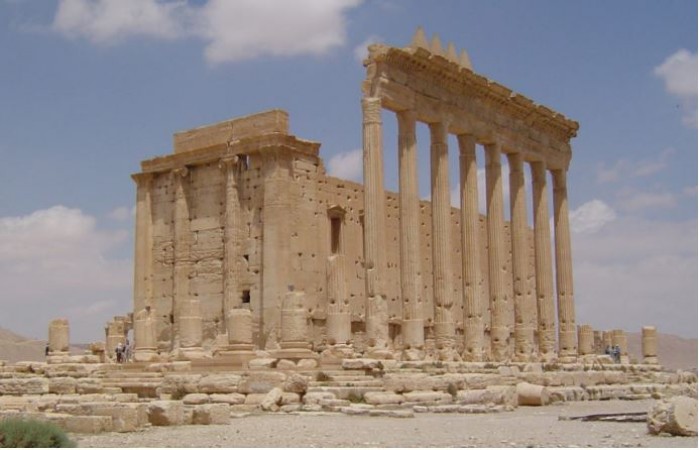
Temple of Bel is also known as the temple of Palmyrene gods, nestled in Dura- Europos, an ancient city on the Euphrates in modern Syria. The Temple of Bel in Dura-Europos was an ancient religious site located in the ancient city of Dura-Europos, which is now in modern-day Syria. The temple was dedicated to the Mesopotamian god Bel, also known as Baal, who was a prominent deity in the ancient Near East. The site is of great archaeological and historical significance, providing valuable insights into the religious practices and cultural interactions of the time.
Dura-Europos was an ancient city situated on the eastern bank of the Euphrates River. It was founded in the 3rd century BCE and had a strategic location that facilitated trade and cultural exchange between the Hellenistic and Persian regions. The city changed hands multiple times over the centuries, being ruled by the Seleucids, Parthians, and Romans, which influenced its architecture and religious beliefs.
Also Read: Naxos, Greece: The Jewel of Cyclades
The Temple of Bel is thought to have been built during the 2nd century CE, at a time when the city was under Roman control. It was a period of relative peace and prosperity for the city, which allowed for the construction of monumental structures like the temple. The dedication to Bel, a deity with origins in Mesopotamia, highlights the syncretism of religious beliefs in the region, blending elements of local and foreign cults.
The Temple of Bel was an imposing and grand structure, reflecting the typical architectural style of Roman temples. The main temple building stood on a raised platform and was accessed via a grand staircase. The entrance was marked by a prominent gateway known as a propylaeum, adorned with decorative elements such as pilasters and friezes. The facade featured intricate carvings depicting religious scenes and mythological figures, which provided valuable insights into the religious beliefs and cultural influences of the time.
Also Read: Skiathos, Greece: A Paradise in the Aegean Sea
The interior of the temple comprised a central hall, known as the cella or naos, where the cult statue of Bel was housed. The cella was often surrounded by a corridor or ambulatory, allowing the devotees to walk around the sacred image during rituals. The walls were decorated with colorful frescoes, and the temple's roof was supported by columns or pillars. The columns were often made of stone or brick, with elaborate capitals and decorative motifs.
The Temple of Bel was a crucial center of religious activity in Dura-Europos. Bel, the god to whom the temple was dedicated, was a prominent deity in the ancient Near East, often associated with fertility, agriculture, and the sky. His worship was widespread, and the temple served as a place of prayer, offerings, and celebrations for the local inhabitants.
Also Read: Tianjin: A Vibrant Metropolis Blending History and Modernity
The cult practices at the Temple of Bel likely involved elaborate rituals, ceremonies, and festivals, aimed at seeking the god's favor, protection, and blessings. The temple priests and priestesses played a vital role in conducting these rituals and maintaining the sacred space. As a result, the temple served not only as a religious site but also as a hub for community gatherings and social interactions.
The discovery of the Temple of Bel occurred during archaeological excavations conducted at Dura-Europos in the 1920s and 1930s. French and American archaeologists led the efforts to unearth the ancient city, revealing a wealth of well-preserved structures, including the temple.
The excavation provided a unique opportunity for scholars to study the architecture, religious practices, and cultural context of the Temple of Bel. The findings included artifacts, inscriptions, and art that shed light on the city's multicultural population and religious syncretism. Unfortunately, due to the tumultuous history of the region, including conflicts and looting, some of the valuable findings have been lost or scattered.
Also Read: Suzhou: A Historical and Picturesque Gem in China
The Temple of Bel in Dura-Europos stands as a testament to the rich history and cultural complexity of the ancient Near East. Its architecture and religious significance offer valuable insights into the blending of local and foreign beliefs in the region. The archaeological excavation of Dura-Europos, including the temple, has provided scholars with a wealth of information about the ancient city and its people. Although the temple has faced the challenges of time and conflicts in the region, its legacy endures through the records of archaeologists and the study of its artifacts and remains. As we continue to explore and learn about ancient civilizations, the Temple of Bel remains an essential piece of the puzzle, contributing to our understanding of the ancient world.
Also Read: Fashion Capital of the World: London